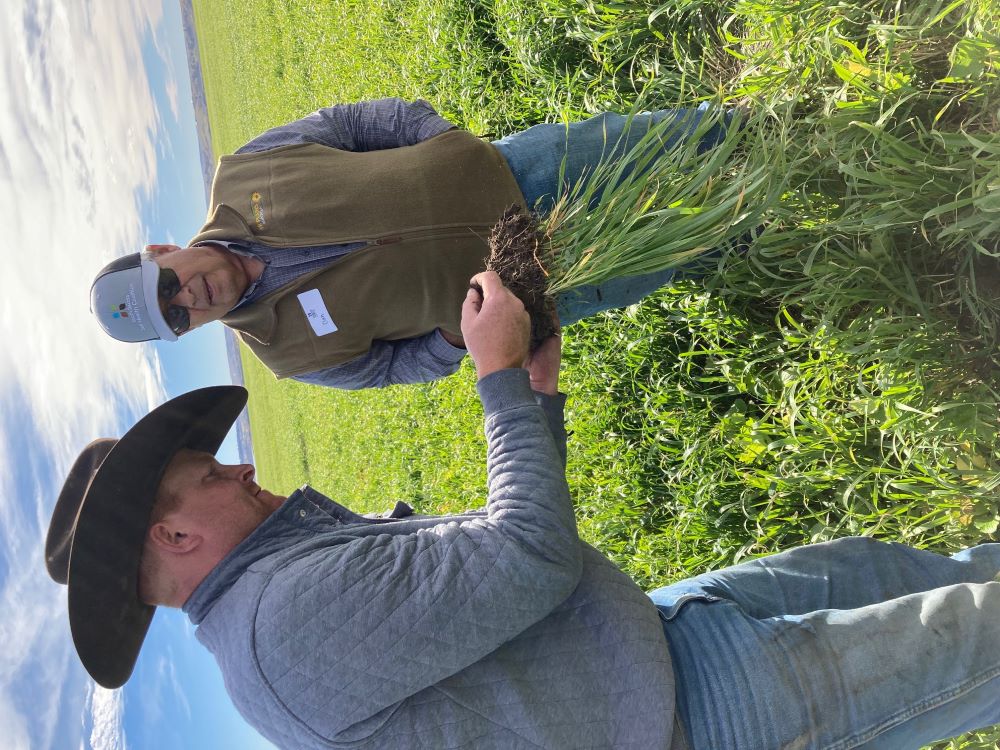Fenceline weaning, cover crops take center stage at Cronin field day
Thursday, November 16, 2023

Tuesday, Oct. 17, offered up a perfect October afternoon in rural South Dakota, with the wind gusting, the sun glinting off of Whitlock Bay in the distance, and the occasional bellowing of a recently-weaned calf.
Occasional because the calf could still see, smell and hear mama cow, who was grazing just on the other side of the fence.
This idyllic scene came courtesy of a Dakota Lakes Research Farm field day held at Cronin Farms near Gettysburg. On the agenda: fenceline weaning and cover crops. Area farmers, ranchers and conservation professionals were on-hand to hear from brothers Corey and Casey Cronin, their dad, Monty, their livestock nutrition consultant, Dale Waldner, and farm agronomist, Dan Forgey.
On the Fence
Weaning is a notoriously stressful time for both calves and dams alike. The abrupt removal of calves from the cows can contribute to decreased feed intake and greater sickness amongst calves, often causing weight loss and sometimes leading to mortality.
Fenceline weaning is a much more natural approach to weaning on pasture. To be successful, experts suggest placing the pairs into the pasture the calves will be in following weaning so they can get accustomed to their surroundings. Then, when it’s time to wean, the cows can simply be moved into the adjacent pasture, where they will still be able to find their babies through the fence.
At the Cronin farm, weaning took place on Saturday, Oct. 14, just three days prior to the field day. The calves stayed in the pasture they had been in, where they had a ¾-mile walk to the river for water. In the new pasture, the dams were provided with water tanks.
Nutritionist Dale Waldner explained that prior to weaning, the calves were given feed in the pasture for about a month prior to weaning. This helps get the calves accustomed to feed so there’s less of an adjustment to life after weaning.
The Cronins used continuous fence between the two pastures, rather than relying on barbed wire or electric fence.
“With electric fencing and wire, you always hear horror stories about calves breaking through fence. We didn’t want any of those problems,” Corey said.
Not only have there been no escape attempts, the Cronins also found there was very little of the customary bawling associated with weaning, and what little there was tapered off quickly.
“As long as the moms and babies can get nose-to-nose, the bawling pretty much stops after the first day,” Casey said.
Monty Cronin, Casey and Corey’s dad, said he was surprised by one thing.
“It seemed to me the cows missed the calves more than the other way around,” he said.
Under Cover
For the second part of the field day, Dan Forgey discussed the cover crop program the farm has adopted on their corn-corn-soybean-spring wheat rotation. While he’s a strong advocate for cover crops in general, he said during dry years like 2023 was – the farm received only about 13.75 inches of precipitation this year -- he only plants cover crops after wheat harvest.
He said during wet cycles, they’ll use cover crops after other crops as well. Rick Bieber, a farmer from Trail City, said another option during dry years is to cut back on the seeding rate rather than cut covers out of the rotation altogether.
“We aim for about one seed per square foot. That will keep the diversity out here to continue feeding the soil biology but won’t take resources away from the crop,” Bieber said.
The Cronin’s cover crop mix of oats, barley, kale and collards was drilled in at a rate of 38 pounds per acre on August 31. The seeds were all mixed together in the hopper, and Forgey said there was no issue with seed separation.
“But we were only seeding about 40 to 50 acres at a time,” he said. “So, we didn’t have any problems.”
The cover crop field in question is adjacent to the weaning pastures as well as some corn fields. Corey said as soon as corn harvest is over, the cows will be let out into the field for grazing. He said the team will put up hot wire fences around the perimeter of the field to keep the cows in and control which parts of the field they have access to.
For water, the cows will have access to Whitlock Bay.
“The bay and the channel will freeze,” said Corey. “But they should have access to water out there until Christmas or so and then we’ll bring them back in.”
Photo: Dan Forgey (right) and Casey Cronin (left) check out the soil structure in a cover crop field seeded after wheat harvest to oats, barley, kale and collards. The field will be grazed this fall and whatever isn’t eaten will winterkill. In the spring, the remaining residue will release nutrients for next year’s corn crop.
Categories: News